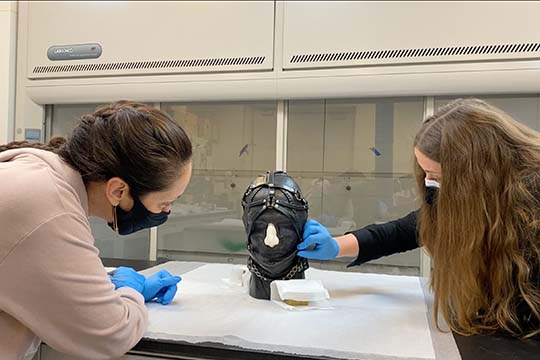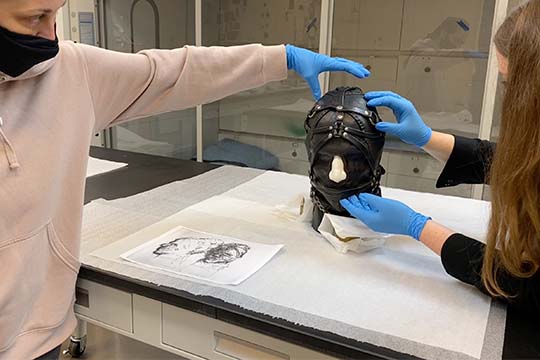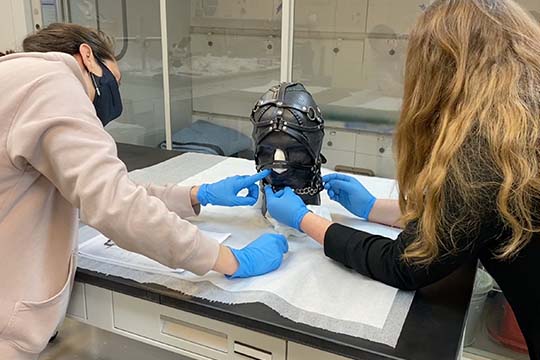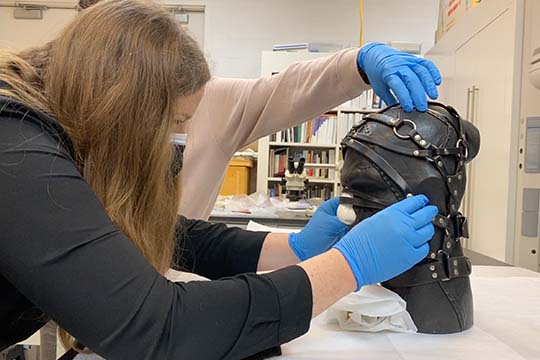The Nasher conservator considers the fragile side of a tough sculptural outlier in Nancy Grossman’s Untitled, Head Sculpture (1968).
When Dr. Catherine Craft shared her findings on the intended location of the leather straps on Nancy Grossman’s Untitled, Head Sculpture (1968), I began the internal preparation process intrinsic to conservation work. With the hope of restoring the original orientation of the straps across the nose came the responsibility to work thoughtfully through a seemingly straightforward treatment. In the end, the strap movement took mere minutes; however, I am trained to consider many factors about a treatment before even touching an artwork.

Object Subjectivity
Perhaps a lesser-known challenge of conserving an artwork comprised of found materials–in this case leather straps and hardware–is an inherent subjectivity in handling familiar objects. As a conservator, it is imperative that I am aware of this and remain impartial when handling these elements. I consider this a common obstacle for anyone working with modern and contemporary art. In this instance, I need to avoid the assumption that the repurposed leather straps have remained supple after many decades. While I have experience treating leather in artworks, historic furniture, and even aviation artifacts, it is important to acknowledge that every object presents unique challenges, especially when a material has lived a previous life.

Leather
The presence of leather within cultural heritage collections can range from bookbinding to upholstery, ethnographic materials to found objects; in each example, the care of the leather is dependent upon its purpose, history, and even how it was first processed. As with other organic materials (composed of carbon compounds), including paper and plastic, leather will have been processed through a multistep procedure to become usable and long-lasting. With leather, this process is called tanning. The two most common tanning methods are vegetable tanning and chrome tanning; both alter the collagen (protein) bonds within the hide to provide durability and prevent putrefaction of the material.

When to Test
In the end, the repositioning of the straps took only gentle coaxing: once the straps were back where they were meant to be, the material memory seemed to encourage them to remain in place. Had additional treatment or repair been necessary, testing the leather to determine how it was originally tanned and processed may have dictated a treatment path. For example, vegetable-tanned leather can be vulnerable to red rot, a deterioration mechanism partially caused by inherent acids present in the leather that can eventually cause material failure. If past handling or movement of the straps had resulted in cracking or tearing of the leather, stabilization may have been required. The selection of conservation materials for leather is influenced by many factors, including the acidity of the substrate. Spot testing can detect weak acids present in vegetable-tanned leather, while elemental analysis like x-ray fluorescence (XRF) can detect heavier elements like metallic chromium in chrome-tanned leather. In some cases, testing leather—either through minimally invasive spot testing or noninvasive XRF—can inform the handling of an artwork in an invaluable way.

Claire Taggart is conservator at the Nasher Sculpture Center.
Reference: AIC, Book and Paper Group. 2021. Animal Skin and Leather Wiki. Accessed March 26, 2021.